Analysis of Key Operational Functions and Managerial Responsibilities
VerifiedAdded on 2021/04/29
|7
|1417
|56
Report
AI Summary
This report delves into the core functions of management and operations within an organization, outlining the key roles and responsibilities of managers across planning, organizing, leading, and controlling. It explores various operational approaches such as Just in Time, TQM, and Lean Output, evaluating their value in enhancing efficiency and productivity. Furthermore, the report assesses the impact of external business environment factors, including organizational resources, financial stability, market trends, and stakeholders, on decision-making processes. It also discusses strategies for improving operational efficiencies to successfully meet business objectives, emphasizing the importance of appropriate management and leadership approaches. Finally, the report provides recommendations based on its findings, highlighting the significance of aligning management theories with practical implementation to achieve optimal outcomes.
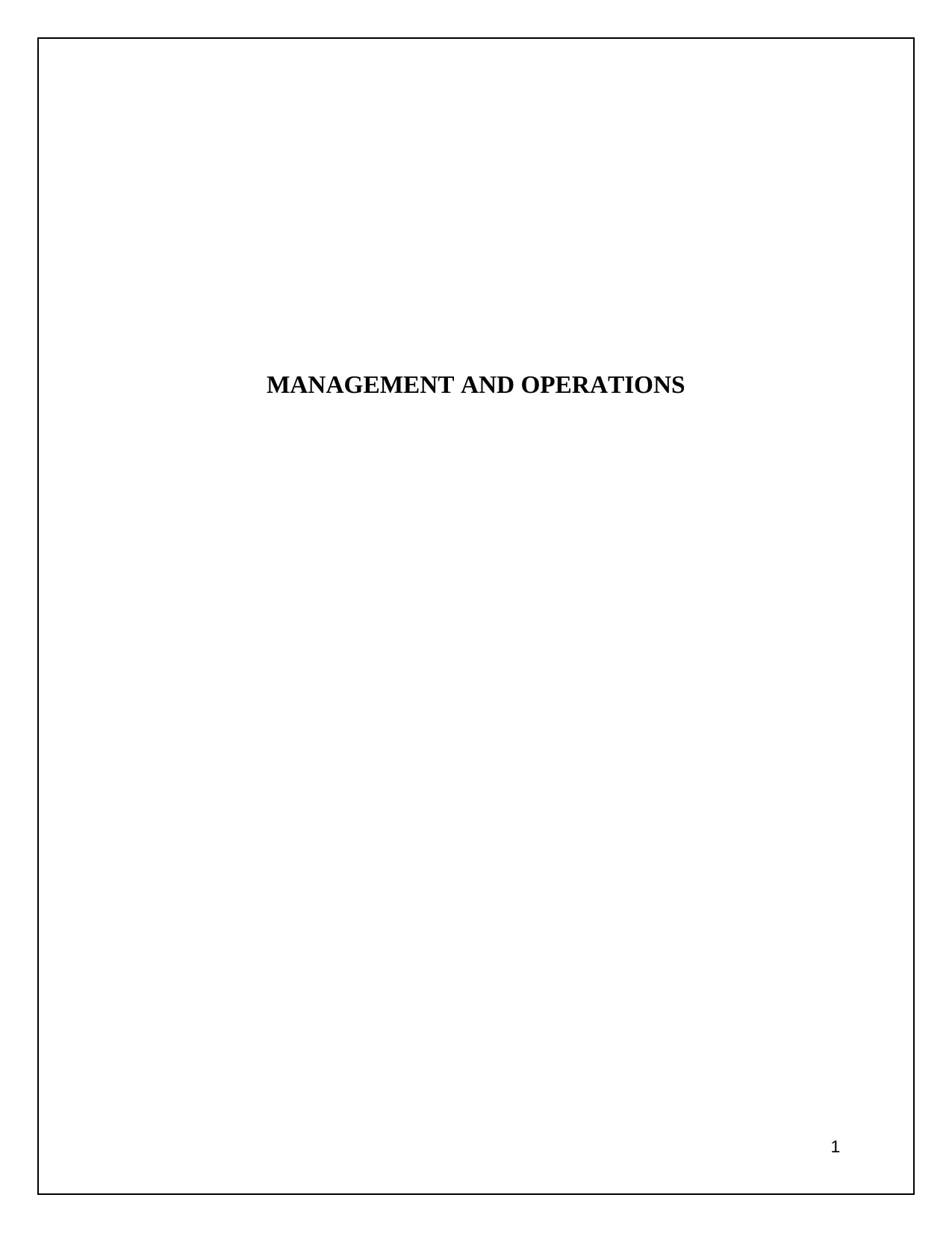
MANAGEMENT AND OPERATIONS
1
1
Paraphrase This Document
Need a fresh take? Get an instant paraphrase of this document with our AI Paraphraser
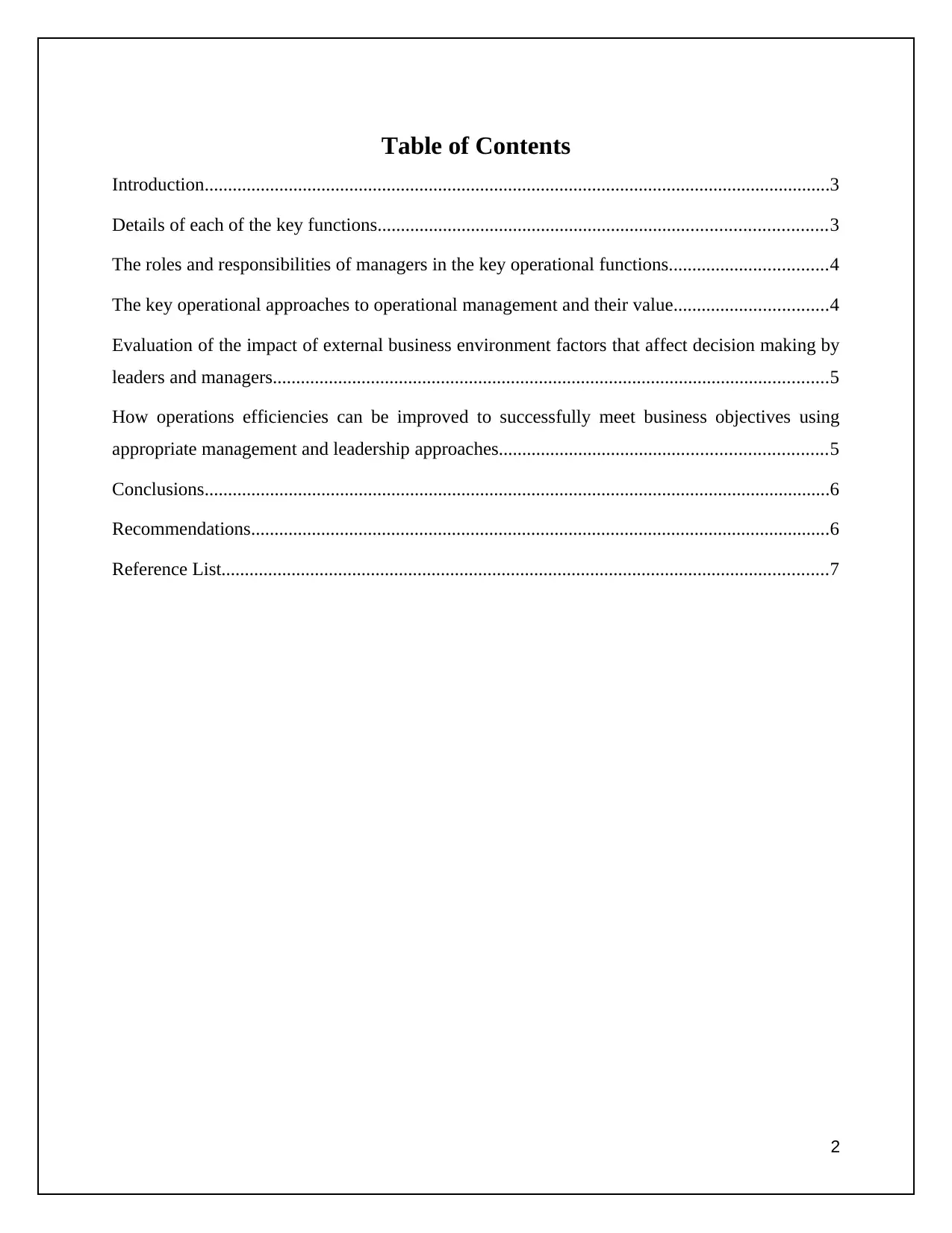
Table of Contents
Introduction......................................................................................................................................3
Details of each of the key functions................................................................................................3
The roles and responsibilities of managers in the key operational functions..................................4
The key operational approaches to operational management and their value.................................4
Evaluation of the impact of external business environment factors that affect decision making by
leaders and managers.......................................................................................................................5
How operations efficiencies can be improved to successfully meet business objectives using
appropriate management and leadership approaches......................................................................5
Conclusions......................................................................................................................................6
Recommendations............................................................................................................................6
Reference List..................................................................................................................................7
2
Introduction......................................................................................................................................3
Details of each of the key functions................................................................................................3
The roles and responsibilities of managers in the key operational functions..................................4
The key operational approaches to operational management and their value.................................4
Evaluation of the impact of external business environment factors that affect decision making by
leaders and managers.......................................................................................................................5
How operations efficiencies can be improved to successfully meet business objectives using
appropriate management and leadership approaches......................................................................5
Conclusions......................................................................................................................................6
Recommendations............................................................................................................................6
Reference List..................................................................................................................................7
2
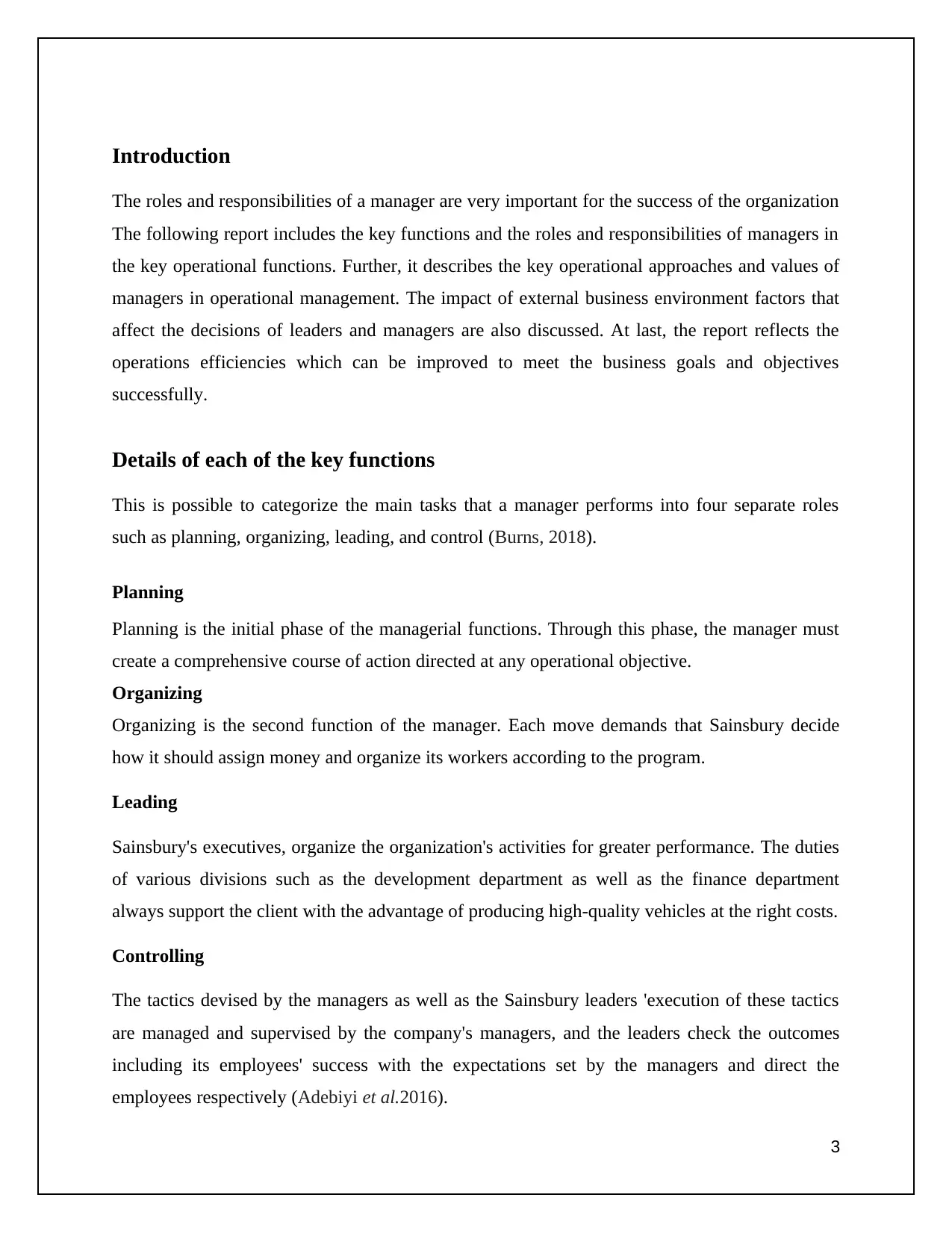
Introduction
The roles and responsibilities of a manager are very important for the success of the organization
The following report includes the key functions and the roles and responsibilities of managers in
the key operational functions. Further, it describes the key operational approaches and values of
managers in operational management. The impact of external business environment factors that
affect the decisions of leaders and managers are also discussed. At last, the report reflects the
operations efficiencies which can be improved to meet the business goals and objectives
successfully.
Details of each of the key functions
This is possible to categorize the main tasks that a manager performs into four separate roles
such as planning, organizing, leading, and control (Burns, 2018).
Planning
Planning is the initial phase of the managerial functions. Through this phase, the manager must
create a comprehensive course of action directed at any operational objective.
Organizing
Organizing is the second function of the manager. Each move demands that Sainsbury decide
how it should assign money and organize its workers according to the program.
Leading
Sainsbury's executives, organize the organization's activities for greater performance. The duties
of various divisions such as the development department as well as the finance department
always support the client with the advantage of producing high-quality vehicles at the right costs.
Controlling
The tactics devised by the managers as well as the Sainsbury leaders 'execution of these tactics
are managed and supervised by the company's managers, and the leaders check the outcomes
including its employees' success with the expectations set by the managers and direct the
employees respectively (Adebiyi et al.2016).
3
The roles and responsibilities of a manager are very important for the success of the organization
The following report includes the key functions and the roles and responsibilities of managers in
the key operational functions. Further, it describes the key operational approaches and values of
managers in operational management. The impact of external business environment factors that
affect the decisions of leaders and managers are also discussed. At last, the report reflects the
operations efficiencies which can be improved to meet the business goals and objectives
successfully.
Details of each of the key functions
This is possible to categorize the main tasks that a manager performs into four separate roles
such as planning, organizing, leading, and control (Burns, 2018).
Planning
Planning is the initial phase of the managerial functions. Through this phase, the manager must
create a comprehensive course of action directed at any operational objective.
Organizing
Organizing is the second function of the manager. Each move demands that Sainsbury decide
how it should assign money and organize its workers according to the program.
Leading
Sainsbury's executives, organize the organization's activities for greater performance. The duties
of various divisions such as the development department as well as the finance department
always support the client with the advantage of producing high-quality vehicles at the right costs.
Controlling
The tactics devised by the managers as well as the Sainsbury leaders 'execution of these tactics
are managed and supervised by the company's managers, and the leaders check the outcomes
including its employees' success with the expectations set by the managers and direct the
employees respectively (Adebiyi et al.2016).
3
⊘ This is a preview!⊘
Do you want full access?
Subscribe today to unlock all pages.

Trusted by 1+ million students worldwide
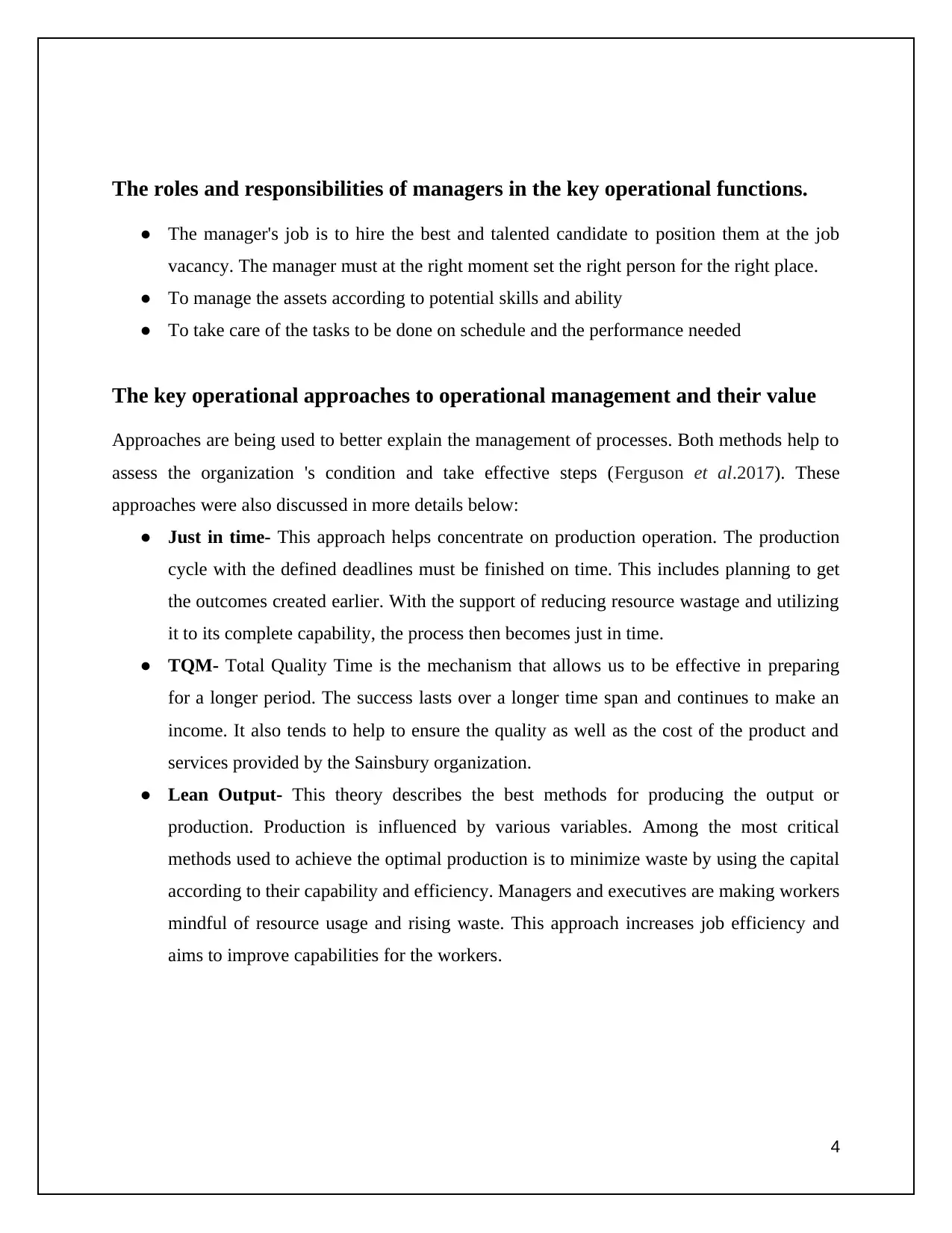
The roles and responsibilities of managers in the key operational functions.
● The manager's job is to hire the best and talented candidate to position them at the job
vacancy. The manager must at the right moment set the right person for the right place.
● To manage the assets according to potential skills and ability
● To take care of the tasks to be done on schedule and the performance needed
The key operational approaches to operational management and their value
Approaches are being used to better explain the management of processes. Both methods help to
assess the organization 's condition and take effective steps (Ferguson et al.2017). These
approaches were also discussed in more details below:
● Just in time- This approach helps concentrate on production operation. The production
cycle with the defined deadlines must be finished on time. This includes planning to get
the outcomes created earlier. With the support of reducing resource wastage and utilizing
it to its complete capability, the process then becomes just in time.
● TQM- Total Quality Time is the mechanism that allows us to be effective in preparing
for a longer period. The success lasts over a longer time span and continues to make an
income. It also tends to help to ensure the quality as well as the cost of the product and
services provided by the Sainsbury organization.
● Lean Output- This theory describes the best methods for producing the output or
production. Production is influenced by various variables. Among the most critical
methods used to achieve the optimal production is to minimize waste by using the capital
according to their capability and efficiency. Managers and executives are making workers
mindful of resource usage and rising waste. This approach increases job efficiency and
aims to improve capabilities for the workers.
4
● The manager's job is to hire the best and talented candidate to position them at the job
vacancy. The manager must at the right moment set the right person for the right place.
● To manage the assets according to potential skills and ability
● To take care of the tasks to be done on schedule and the performance needed
The key operational approaches to operational management and their value
Approaches are being used to better explain the management of processes. Both methods help to
assess the organization 's condition and take effective steps (Ferguson et al.2017). These
approaches were also discussed in more details below:
● Just in time- This approach helps concentrate on production operation. The production
cycle with the defined deadlines must be finished on time. This includes planning to get
the outcomes created earlier. With the support of reducing resource wastage and utilizing
it to its complete capability, the process then becomes just in time.
● TQM- Total Quality Time is the mechanism that allows us to be effective in preparing
for a longer period. The success lasts over a longer time span and continues to make an
income. It also tends to help to ensure the quality as well as the cost of the product and
services provided by the Sainsbury organization.
● Lean Output- This theory describes the best methods for producing the output or
production. Production is influenced by various variables. Among the most critical
methods used to achieve the optimal production is to minimize waste by using the capital
according to their capability and efficiency. Managers and executives are making workers
mindful of resource usage and rising waste. This approach increases job efficiency and
aims to improve capabilities for the workers.
4
Paraphrase This Document
Need a fresh take? Get an instant paraphrase of this document with our AI Paraphraser
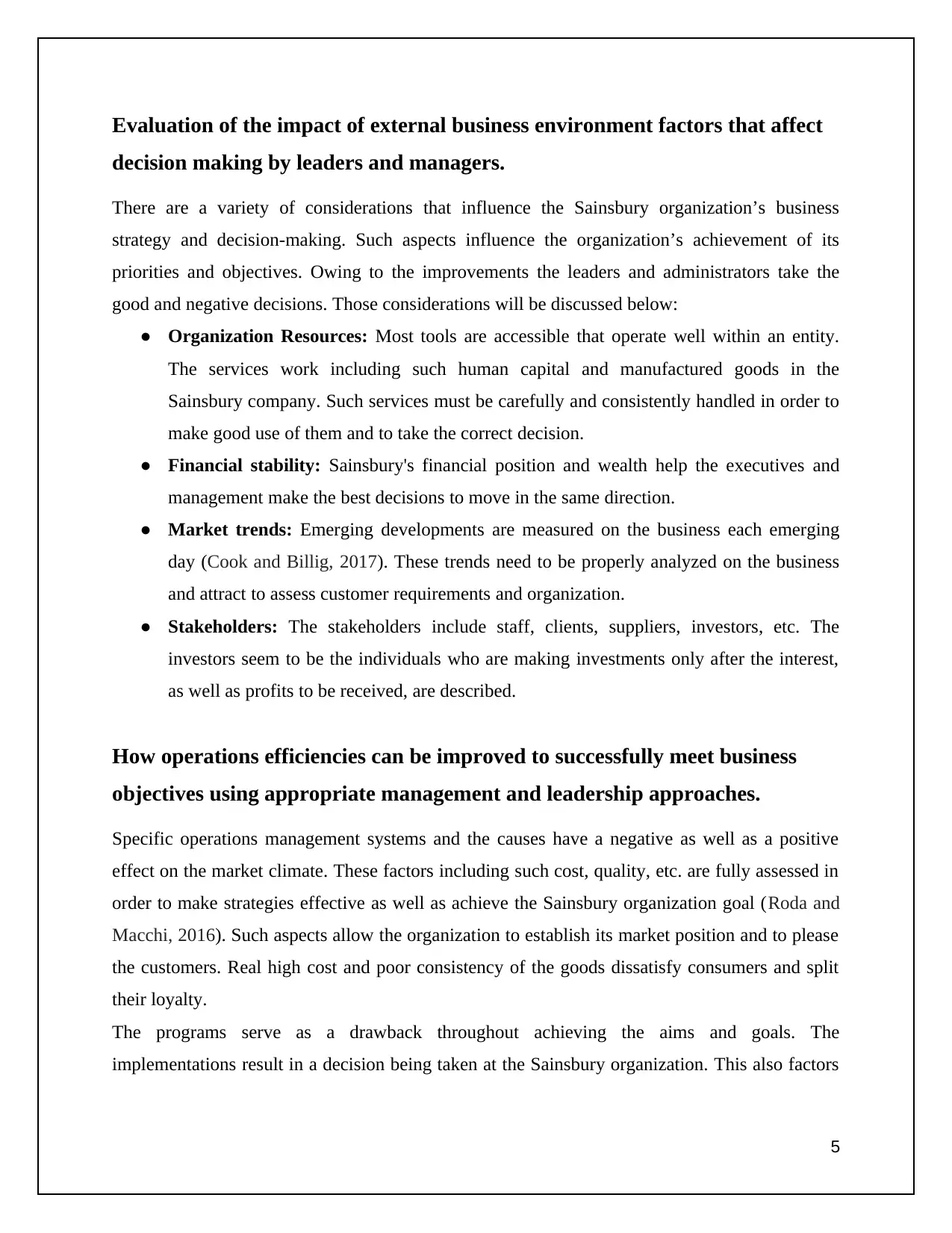
Evaluation of the impact of external business environment factors that affect
decision making by leaders and managers.
There are a variety of considerations that influence the Sainsbury organization’s business
strategy and decision-making. Such aspects influence the organization’s achievement of its
priorities and objectives. Owing to the improvements the leaders and administrators take the
good and negative decisions. Those considerations will be discussed below:
● Organization Resources: Most tools are accessible that operate well within an entity.
The services work including such human capital and manufactured goods in the
Sainsbury company. Such services must be carefully and consistently handled in order to
make good use of them and to take the correct decision.
● Financial stability: Sainsbury's financial position and wealth help the executives and
management make the best decisions to move in the same direction.
● Market trends: Emerging developments are measured on the business each emerging
day (Cook and Billig, 2017). These trends need to be properly analyzed on the business
and attract to assess customer requirements and organization.
● Stakeholders: The stakeholders include staff, clients, suppliers, investors, etc. The
investors seem to be the individuals who are making investments only after the interest,
as well as profits to be received, are described.
How operations efficiencies can be improved to successfully meet business
objectives using appropriate management and leadership approaches.
Specific operations management systems and the causes have a negative as well as a positive
effect on the market climate. These factors including such cost, quality, etc. are fully assessed in
order to make strategies effective as well as achieve the Sainsbury organization goal (Roda and
Macchi, 2016). Such aspects allow the organization to establish its market position and to please
the customers. Real high cost and poor consistency of the goods dissatisfy consumers and split
their loyalty.
The programs serve as a drawback throughout achieving the aims and goals. The
implementations result in a decision being taken at the Sainsbury organization. This also factors
5
decision making by leaders and managers.
There are a variety of considerations that influence the Sainsbury organization’s business
strategy and decision-making. Such aspects influence the organization’s achievement of its
priorities and objectives. Owing to the improvements the leaders and administrators take the
good and negative decisions. Those considerations will be discussed below:
● Organization Resources: Most tools are accessible that operate well within an entity.
The services work including such human capital and manufactured goods in the
Sainsbury company. Such services must be carefully and consistently handled in order to
make good use of them and to take the correct decision.
● Financial stability: Sainsbury's financial position and wealth help the executives and
management make the best decisions to move in the same direction.
● Market trends: Emerging developments are measured on the business each emerging
day (Cook and Billig, 2017). These trends need to be properly analyzed on the business
and attract to assess customer requirements and organization.
● Stakeholders: The stakeholders include staff, clients, suppliers, investors, etc. The
investors seem to be the individuals who are making investments only after the interest,
as well as profits to be received, are described.
How operations efficiencies can be improved to successfully meet business
objectives using appropriate management and leadership approaches.
Specific operations management systems and the causes have a negative as well as a positive
effect on the market climate. These factors including such cost, quality, etc. are fully assessed in
order to make strategies effective as well as achieve the Sainsbury organization goal (Roda and
Macchi, 2016). Such aspects allow the organization to establish its market position and to please
the customers. Real high cost and poor consistency of the goods dissatisfy consumers and split
their loyalty.
The programs serve as a drawback throughout achieving the aims and goals. The
implementations result in a decision being taken at the Sainsbury organization. This also factors
5
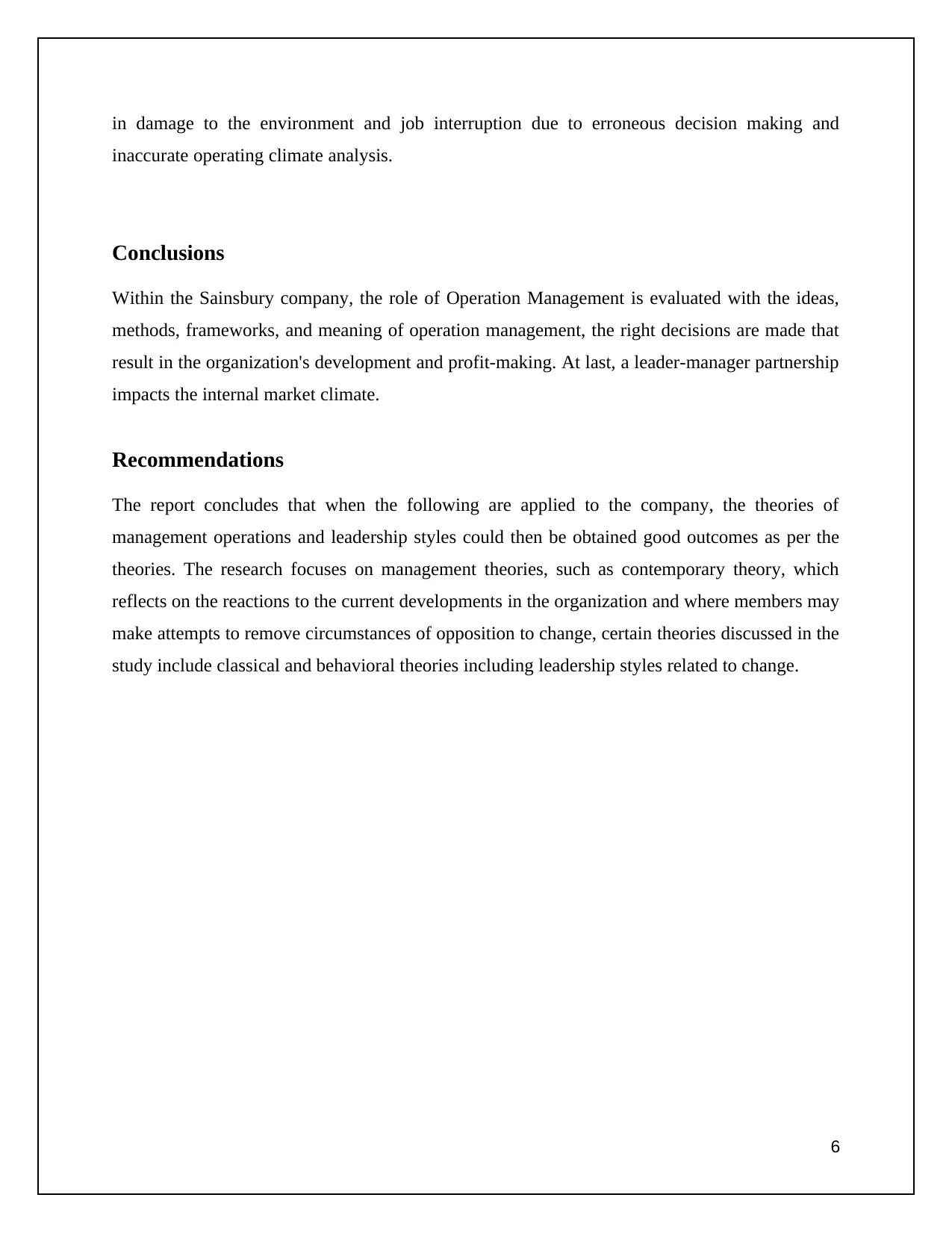
in damage to the environment and job interruption due to erroneous decision making and
inaccurate operating climate analysis.
Conclusions
Within the Sainsbury company, the role of Operation Management is evaluated with the ideas,
methods, frameworks, and meaning of operation management, the right decisions are made that
result in the organization's development and profit-making. At last, a leader-manager partnership
impacts the internal market climate.
Recommendations
The report concludes that when the following are applied to the company, the theories of
management operations and leadership styles could then be obtained good outcomes as per the
theories. The research focuses on management theories, such as contemporary theory, which
reflects on the reactions to the current developments in the organization and where members may
make attempts to remove circumstances of opposition to change, certain theories discussed in the
study include classical and behavioral theories including leadership styles related to change.
6
inaccurate operating climate analysis.
Conclusions
Within the Sainsbury company, the role of Operation Management is evaluated with the ideas,
methods, frameworks, and meaning of operation management, the right decisions are made that
result in the organization's development and profit-making. At last, a leader-manager partnership
impacts the internal market climate.
Recommendations
The report concludes that when the following are applied to the company, the theories of
management operations and leadership styles could then be obtained good outcomes as per the
theories. The research focuses on management theories, such as contemporary theory, which
reflects on the reactions to the current developments in the organization and where members may
make attempts to remove circumstances of opposition to change, certain theories discussed in the
study include classical and behavioral theories including leadership styles related to change.
6
⊘ This is a preview!⊘
Do you want full access?
Subscribe today to unlock all pages.

Trusted by 1+ million students worldwide
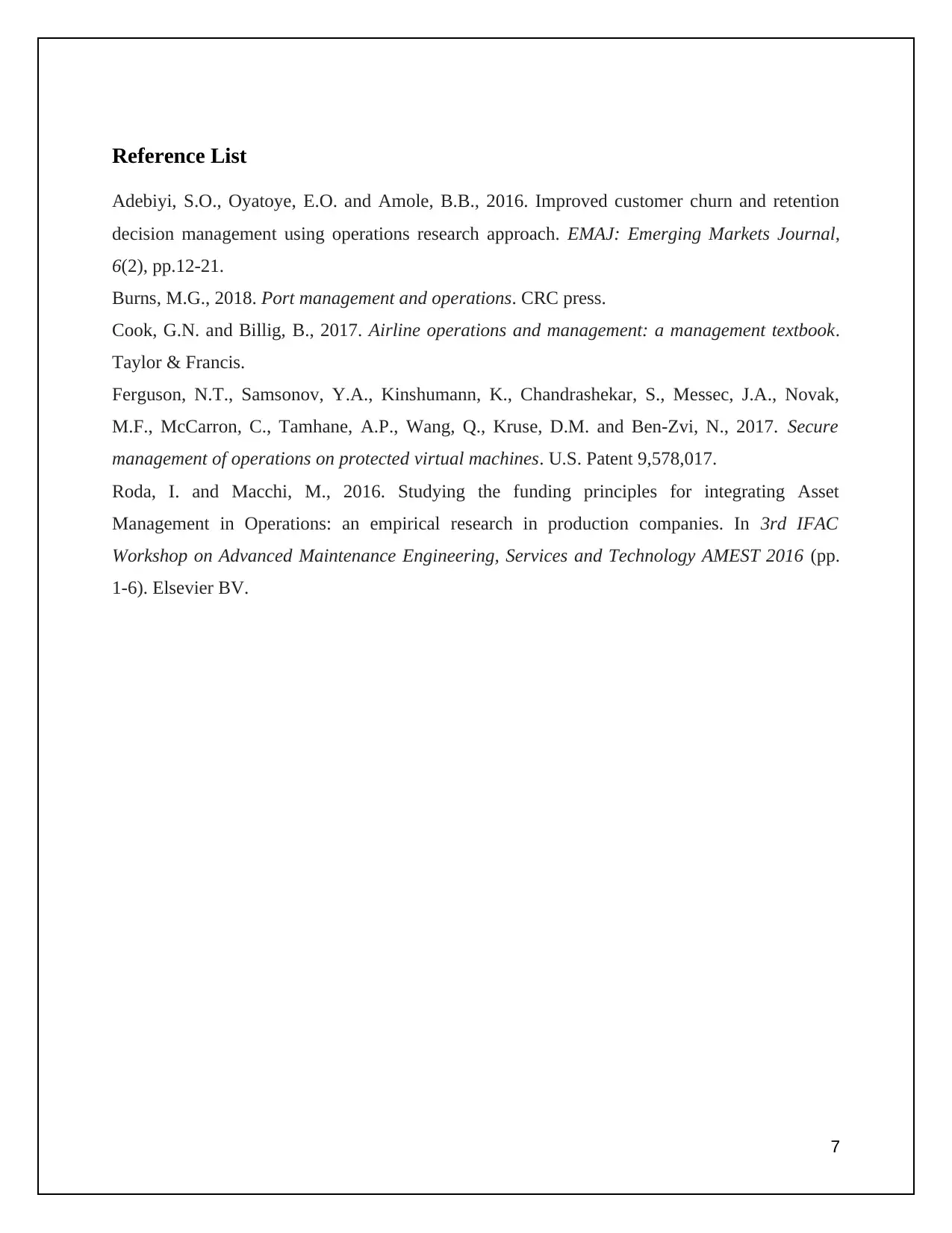
Reference List
Adebiyi, S.O., Oyatoye, E.O. and Amole, B.B., 2016. Improved customer churn and retention
decision management using operations research approach. EMAJ: Emerging Markets Journal,
6(2), pp.12-21.
Burns, M.G., 2018. Port management and operations. CRC press.
Cook, G.N. and Billig, B., 2017. Airline operations and management: a management textbook.
Taylor & Francis.
Ferguson, N.T., Samsonov, Y.A., Kinshumann, K., Chandrashekar, S., Messec, J.A., Novak,
M.F., McCarron, C., Tamhane, A.P., Wang, Q., Kruse, D.M. and Ben-Zvi, N., 2017. Secure
management of operations on protected virtual machines. U.S. Patent 9,578,017.
Roda, I. and Macchi, M., 2016. Studying the funding principles for integrating Asset
Management in Operations: an empirical research in production companies. In 3rd IFAC
Workshop on Advanced Maintenance Engineering, Services and Technology AMEST 2016 (pp.
1-6). Elsevier BV.
7
Adebiyi, S.O., Oyatoye, E.O. and Amole, B.B., 2016. Improved customer churn and retention
decision management using operations research approach. EMAJ: Emerging Markets Journal,
6(2), pp.12-21.
Burns, M.G., 2018. Port management and operations. CRC press.
Cook, G.N. and Billig, B., 2017. Airline operations and management: a management textbook.
Taylor & Francis.
Ferguson, N.T., Samsonov, Y.A., Kinshumann, K., Chandrashekar, S., Messec, J.A., Novak,
M.F., McCarron, C., Tamhane, A.P., Wang, Q., Kruse, D.M. and Ben-Zvi, N., 2017. Secure
management of operations on protected virtual machines. U.S. Patent 9,578,017.
Roda, I. and Macchi, M., 2016. Studying the funding principles for integrating Asset
Management in Operations: an empirical research in production companies. In 3rd IFAC
Workshop on Advanced Maintenance Engineering, Services and Technology AMEST 2016 (pp.
1-6). Elsevier BV.
7
1 out of 7
Related Documents
Your All-in-One AI-Powered Toolkit for Academic Success.
+13062052269
info@desklib.com
Available 24*7 on WhatsApp / Email
![[object Object]](/_next/static/media/star-bottom.7253800d.svg)
Unlock your academic potential
Copyright © 2020–2025 A2Z Services. All Rights Reserved. Developed and managed by ZUCOL.




